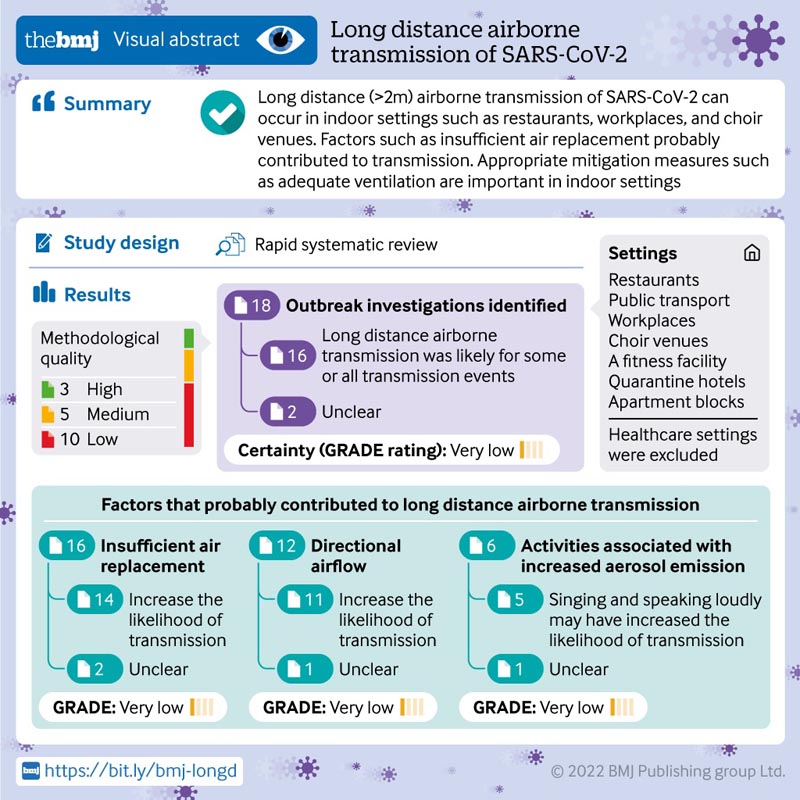Summary Goals To evaluate the potential for long-distance airborne transmission of SARS-CoV-2 in closed community settings and investigate factors that could influence transmission. Design : Rapid systematic review and narrative synthesis. Data sources Medline, Embase, medRxiv, Arxiv and the WHO COVID-19 Research Database for studies published from July 27, 2020 to January 19, 2022; Existing relevant rapid systematic review for studies published from January 1, 2020 to July 27, 2020; and citation analysis in Web of Science and Cocites. Eligibility criteria for study selection Observational studies reporting transmission events in indoor community (non-healthcare) settings where long-distance airborne transmission of SARS-CoV-2 was the most likely route. Studies such as those of household transmission in which the primary route of transmission was likely to be close contact or fomite transmission were excluded. Data extraction and synthesis One reviewer performed data extraction and a second reviewer independently verified data. The primary outcomes were SARS-CoV-2 infections via long-distance airborne transmission (>2 m) and any modifying factors. The methodological quality of the included studies was rated using the quality criteria checklist, and the certainty of the primary outcomes was determined using the Grading of Recommendations, Assessment, Development, and Evaluation (GRADE) framework. The narrative synthesis was themed by setting. Results 22 reports related to 18 studies were identified (methodological quality was high in three, medium in five and low in 10); all studies were outbreak investigations. Long-distance airborne transmission was likely to have occurred for some or all transmission events in 16 studies and was unclear in two studies (GRADE: very low certainty). In all 16 studies, one or more factors plausibly increased the likelihood of long-distance airborne transmission, particularly insufficient air replacement (very low certainty), directional airflow (very low certainty), and activities associated with increased aerosol emission, such as singing or talking loudly (very low certainty). In 13 studies, primary cases were reported as asymptomatic, presymptomatic, or around the onset of symptoms at the time of transmission. Although some of the included studies were well-conducted outbreak investigations, they remain at risk of bias due to study design and do not always provide the level of detail necessary to fully assess transmission routes. Conclusion This rapid systematic review found evidence suggesting that long-distance airborne transmission of SARS-CoV-2 could occur in indoor settings such as restaurants, workplaces, and choir venues, and identified factors such as insufficient air replacement that likely contributed to the broadcast. These results reinforce the need for mitigation measures in indoor environments, particularly the use of adequate ventilation. PROSPERO Systematic Review Registry CRD42021236762. |

Comments
This review adds further weight to growing evidence of ’long-distance’ airborne transmission of Covid in indoor settings such as restaurants, workplaces and public transport
Some public places may need better ventilation to prevent the spread of Covid-19 following growing evidence of the potential for "long-distance" airborne transmission of the disease, research published in The BMJ suggests.
A review of 18 existing studies indicates that airborne transmission of the SARS-CoV-2 virus from an infectious individual to others located more than two meters away can occur in different indoor, non-healthcare settings.
However, the researchers emphasize that the evidence from these studies was considered to be of very low certainty and say that continued research is needed into the potential for long-distance airborne transmission of SARS-CoV-2.
Since the early stages of the Covid-19 pandemic and so-called "superspreader" events , there has been growing evidence to suggest that airborne transmission of the SARS-CoV-2 virus in places with poor ventilation has helped spread the infection.
It is generally accepted that short-distance transmission (less than two meters away) can occur through both droplets and airborne aerosols, but there is no agreement on the importance of long- distance transmission (more than two meters away). meters) in indoor environments. such as hospitality venues, leisure facilities, workplaces or apartment blocks.
Therefore, a team of researchers from the UK Health Security Agency and the University of Bristol set out to assess the potential for long-distance airborne transmission of SARS-CoV-2 in closed community settings and investigate the factors that could influence transmission.
They reviewed studies on the topic published between January 2020 and January 2022, focusing on 18 observational studies of Covid outbreaks in countries in Asia, Europe, Oceania and the US.
These outbreaks occurred in various community settings, including flats in apartment blocks, quarantine hotels, restaurants, buses, a food processing factory, a court, a gym, and during singing events.
The review authors concluded that long-distance airborne transmission was likely to occur for some or all transmission events in 16 of 18 studies. It was not clear in the other two studies.
In all 16 studies, one or more factors are likely to have increased the chances of long-range airborne transmission, particularly insufficient air replacement, directional airflow, and activities associated with increased aerosol emission, such as singing or speaking out loud.
In 13 studies, people likely to be the source of infection were reported to be asymptomatic, presymptomatic, or just beginning to have symptoms at the time of transmission.
The review has some limitations , for example, it only looked at epidemiological observational studies of real-world human-to-human transmission events and did not include broader evidence from environmental or experimental studies.
Furthermore, most outbreaks occurred before vaccine implementation and it is unclear how these results apply to populations with a high level of immunity to infection, whether naturally acquired or vaccine-mediated.
However, the review critically assessed the likelihood of long-distance airborne transmission of SARS-CoV-2 using a range of evidence, from epidemiological data, genomic analysis and video surveillance to seating arrangement analysis and environmental hypothesis testing. .
As such, the authors conclude: This rapid systematic review demonstrates existing evidence that long-distance airborne transmission of SARS-CoV-2 can occur in indoor settings such as restaurants, workplaces, and choir venues, and identified factors such as insufficient air replacement that may contribute to transmission.
“These results support the role of mitigation measures in indoor environments, such as adequate ventilation,”
Now is the time for an indoor air revolution , argues Stephanie Dancer, a consultant microbiologist at Edinburgh Napier University, in a linked editorial.
It also notes some limitations of the study, but says that “the evidence presented in this review, however tenuous, validates the premise that tiny respiratory particles containing SARS-CoV-2 are freely transmitted in environments with inadequate ventilation.
“Public health leaders are expected to develop practical guidance and “tip” people and places closer to safety,” he concludes.
















